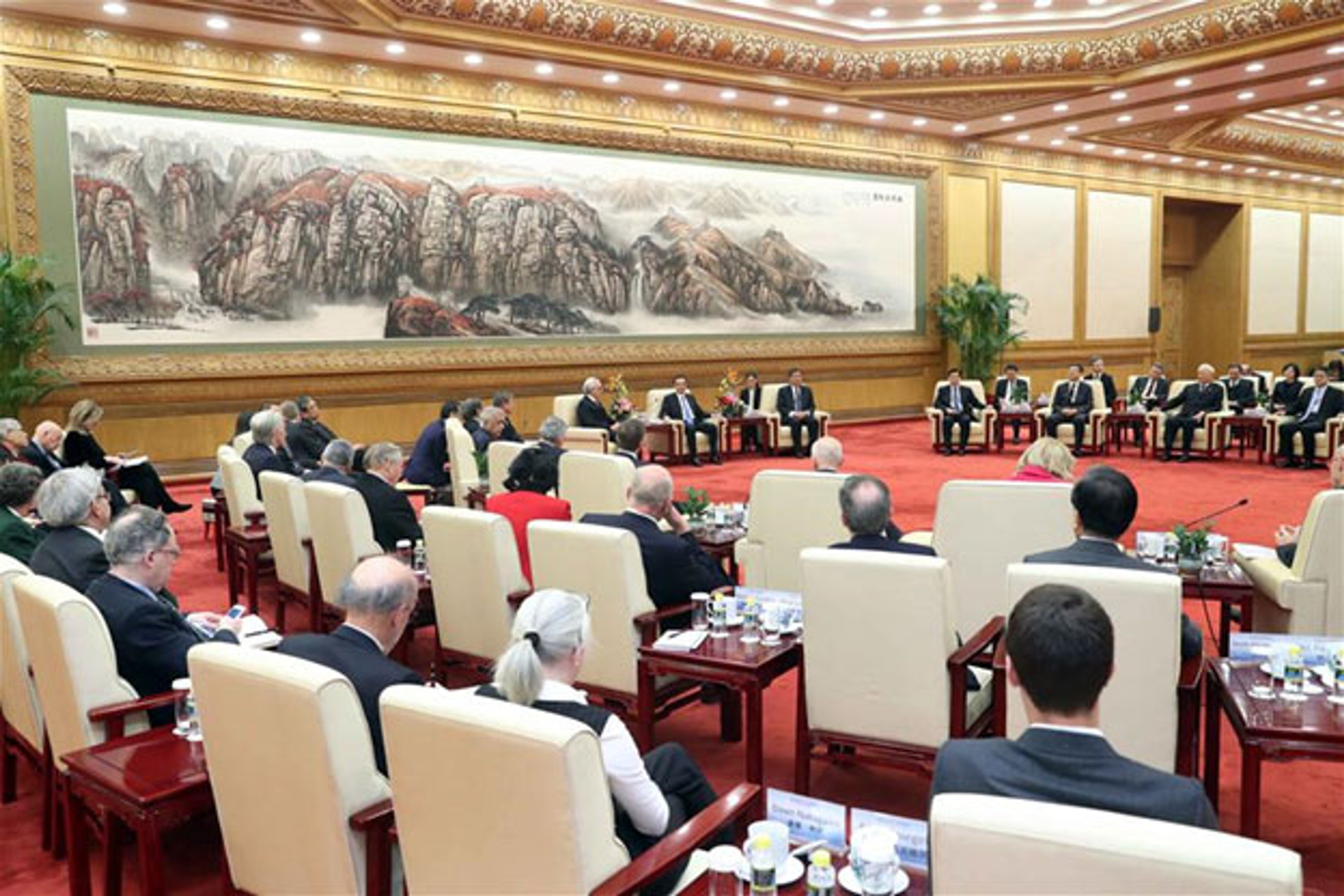Zheng Bijian Remarks at 21st Century Council London Seminar on China in the New Era
The theme of the seminar today is “China in the New Era”. By “new era” we refer specifically to the new era of socialism with Chinese characteristics. It is well-known that socialism with Chinese characteristics is a distinctive and innovative development path for China put forward by Deng Xiaoping in the great experiment of reform and opening up. In essence, it means that China must independently develop socialism with Chinese characteristics in the process of reform and opening up by embracing economic globalization rather than detaching ourselves from it.
In this context of economic globalization, let me post – and answer – three questions: where did “China in the new era” come from? Where are we now? And where are we going?
First question: where does China in the new era come from?
Let’s start with the historical process since the modern times. A prominent fact of China is that the major social changes that have taken place in modern China are closely related to the great changes in the world, especially the three major rounds of economic globalization. This is an important and indispensable perspective when observing issues concerning China.
Mario Monti at Seminar on “China in the New Era” held in London, 2018.
The first round of economic globalization began in the 16th century and flourished in the mid-18th century. At that time, the arrogant Qing government in China turned a blind eye to the ongoing industrial revolution and missed a major development opportunity offered by the first round of economic globalization. In 1840, China was defeated in the first Opium War and in the same year, the domestic railway network in Britain was completed. It is not a coincidence in time. It illustrates that the day when the British accomplished their industrial revolution was exactly the time when China was relegated to a semi-colonial society. In a word, from mid-18th century to the end of 19th century, because the Chinese missed the historical opportunities presented by industrial revolution and economic globalization, China lagged behind and fell from the zenith of prosperity to the rock bottom of misery.
But at the same time, the Chinese had never given up their struggle to “save the country from demise” and to “rejuvenate and develop the nation”, as demonstrated by Lin Zexu, who was applauded as “the first person to open his eyes to the outside world” and Dr. Sun Yat-sen, the great revolutionary pioneer and founder of the Republic of China, who called on the Chinese people to “rejuvenate China” and led the 1911 Revolution, which overthrew the autocratic monarchy system that dominated the country for thousands of years, initiating modern national democratic revolution in the full sense and bringing China to its first historic turning point. The Revolution of 1911 failed to change the nature of the old Chinese society or save the people from suffering, and the country continued on its trajectory of decline, but it paved the way for progress. That is China’s fate in the first round of economic globalization.
The second round of economic globalization began in late 19th and early 20th century, when Western capitalist countries entered the stage of imperialism dominated by financial capital. However, the two world wars that spanned for more than 30 years in the first half of the 20th century interrupted this process. With imperialist powers staking out their sphere of influence in China and under the threat of large-scale wars of aggression, the Chinese rose to make revolutions when the second round of economic globalization came to a halt. The Communist Party of China came into being at that moment. Led by the first generation of central leadership with Mao Zedong at the core, the Chinese founded the People’s Republic, achieved national independence and liberation, and moved from new-democratic revolution to socialist development, when great achievements were made. That is China’s fate in the second round of economic globalization.
Seminar on “China in the New Era” held in London, 2018.
The third round of economic globalization began in the late 1970s and early 1980s, when the United States failed in the Vietnam War and the former Soviet Union suffered setbacks in the Afghanistan War. As the two superpowers capable ofwaging world wars were seriously frustrated in their global strategies, the world gradually entered a new period with peace and development as the theme of the times. In particular, with the rapid development of the new technology revolution, the flow of information, capital, and goods accelerated at a global level andtransnational companies flourished, giving rise to the third round of economic globalization. Just at that moment, in 1978, the third plenary session of the Eleventh Central Committee of the Communist Party of China decided to implement reforms and open up to the outside world. That was a new revolution initiated under the leadership of the second generation of central leadership with Deng Xiaoping at the core. The Chinese seized the new opportunities offered by the times. Based on over 30 years of hard work and lessons learned from historical experience, the Chinesehave successfully created a modelofindependently building socialism with Chinese characteristics by embracing rather than detaching from economic globalization, which is China’s path of peaceful rise and peaceful development. It was remarkable to the world that socialist China exhibited enormous vigor and vitality in the reform and opening up process. By 2010, China had surpassed Japan to become the second largest economy in the world. That is China’s fate in the third round of economic globalization.
The 19th National Congress of the CPC in 2017, when reviewing the historic changes and achievements made since the initiation of reform and opening up program in general, and the five years since the 18th CPC National Congress in particular, pointed out: “with decades of hard work, socialism with Chinese characteristics has crossed the threshold into a new era. This is a new historic juncture for China’s development.” As we discuss “China in the new era” today, we must understand the context it comes from, which is the development process of socialism with Chinese characteristics linked to the third round of economic globalization.
Second question: Where does China stand now in the new era?
To understand China, we not only need to understand where China came from, but also where it stands now. And to understand the historical juncture China stands at in the new era, we must first understand where the world is in the historical context, especially where economic globalization is situated. And secondly we must understand the current historical juncture in China’s development. They are what we often refer to as the international and domestic situations that we must fully appreciate and take into consideration.
First, internationally, we realize that a new round of economic globalization is on the horizon.
We have noticed that over the 40 years since this round of economic globalization started in 1970s, we have enjoyed great economic achievements, but, at the same time, witnessed a lot of problems piling up. The third round of globalization, initiated by the United States, has both made tremendous contributions to world economic growth on the one hand and brought with it obvious flaws on the other. Many problems have now come to the fore in some countries, first and foremost, the United States, and they have further affect the whole world.
Berggruen Institute Co-Founder Nathan Gardels at the Seminar on “China in the New Era” held in London, 2018.
A prominent problem of today is the fierce denunciation of economic globalization, focusing on the flaws of globalization as an excuse. Those who lash out against globalization even blame their domestic problems and difficulties on other countries. In fact, the United States is the biggest beneficiary of this round of economic globalization. However, as they pursued excessive profits across the globe, they did not hesitate at hollowing out some parts of their domestic economy and readily allowed fictitious economy to throw the door open for exorbitantly profitable speculations, leading to the outbreak of a financial crisis. And today, facing problems such as high unemployment, increased inequality, social disintegration, and the sharp rise of populism, instead of conducting domestic reforms and facilitating the liberalization of international trade and investment, they are promoting protectionism and threatening trade wars in total disregard of international rules, gravely damaging their international image, and more importantly, it does nobody any good, and only works to harm the world economy.
So what is the solution? On January 17 last year, President Xi Jinping, in his speech at the World Economic Forum in Davos, clearly pointed out: “…the right thing to do is to seize every opportunity, jointly meet challenges and chart the right course for economic globalization”. In fact, economic globalization, instead of being reversed, is expanding and deepening. We are ushering in the fourth round of economic globalization. Especially with the “Belt and Road Initiative” proposed by China, economic globalization is expected to expand gradually from a globalization of maritime economy which has linked the Atlantic Ocean and the Pacific Ocean together in the past 400 years to one that will integrate maritime economy with inland economy for the first time in human history. With the help of social informatization that is driven by the rapid development of networks, digital and smart technologies, the fourth round of economic globalization is coming with strong momentum.
Domestically, China, as the largest developing country in the world, is working hard to secure a decisive victory in building a moderately prosperous society in all aspects and to fully build a great modern socialist country.
The 19th CPC National Congress has formulated a program and a road map for achieving such a goal. Of course, the Communist Party of China is not complacent with the achievements it has made or the blueprints it has drawn up. We have made it very clear that the basic dimension of the Chinese context — that our country is still and will long remain in the primary stage of socialism — has not changed, and that China’s international status as the world’s largest developing country has not changed. The fact is that although China is now the world’s second largest economy, with GDP reaching USD12.2 trillion in 2017, its per capita GDP equals only to USD 8905, once the national figure is divided by a population of 1.37 billion. Although China’s manufacturing output value has become the highest in the world, the country is still in the process of upgrading from lower end to higher end of the value chain. We are not only lagging behind the United States, but also Europe and Japan. Besides, there is a large disparity between the urban and rural areas, between the eastern and the western parts of China, and between the northern and southern regions of the country, both in terms of levels of development and resident income. In other words, in the new era, China defines itself as a large developing country that is getting stronger and is working hard to create a better life for its people.
Seminar on “China in the New Era” held in London, 2018.
The way history moves forward is very interesting. Just when the world is approaching the fourth round of economic globalization, socialism with Chinese characteristics has entered a “new era”. This synchronicity in time will enhance and benefit both China and the world.
Third question: Where is China heading in the new era?
China has already laid out the milestones for its journey: by 2020, finish building a moderately prosperous society in all aspects; by 2035, basically realize socialist modernization; and by 2050, develop China into a great modern socialist country that is prosperous, strong, democratic, culturally advanced and harmonious.
China’s progress and prospects are received with applause by some and annoyance or even anger by others. As socialism with Chinese characteristics enters a new era, the chatter of “China threat”, “Thucydides trap”, “China collapse”, and “middle income trap” that has been going on over the years has once again grown much louder. Such noises are not surprising. It would have been strange if we had not heard such rhetoric. But the Chinese people, with full commitment to our own strategic goals and focus, do have the ability to keep things under control and rise peacefully in the complex situation of economic globalization.
For us Chinese, we have always believed that China will do well only when the world does well, and vice versa. President Xi Jinping declared to the world in his speech last year at the UN Office in Geneva that China remains unchanged in its commitment to uphold world peace; China remains unchanged in its commitment to pursue common development;China remains unchanged in its commitment to foster partnerships; China remains unchanged in its commitment to multilateralism. These four commitments demonstrate to the world that China will never waver in its pursuit of peaceful development.
Several centuries ago, China was strong and its GDP accounted for 30% of the global total. Even then, China was never engaged in aggression or expansion.China suffered immensely from foreign aggression in modern times, and we Chinese firmly believe that peace and stability is the only way to development and prosperity.No matter how strong its economy grows, China will never seek hegemony, expansion or sphere of influence. History has borne this out and will continue to do so. I also wish to inform our foreign friends that just last month, “following the path of peaceful development” was included in the Constitution of the People’s Republic of China.
We are all aware that the world has witnessed and will continue to witness historic changes in many different aspects. From the Cold War confrontation between the East and the West to the emergence of a world pattern of “one super power and many strong powers” to a structure of co-governance by “G20”, and then to a “multi-polar” world, the international community is moving forward step by step in accordance with this historical logic. The fourth round of economic globalization where countries achieve shared growth through discussion and collaboration is approaching. China welcomes such a historic turning point by putting forward a new concept of “community with shared future”.
I remember on October 26, 2011, at the invitation of the 21st Century Council, I gave a keynote address at the Council’s Paris Forum. In my speech, I elaborated a strategic vision of “expanding and deepening convergence of interests of all parties and gradually developing all-dimensional and multi-level communities of interests”, which was unanimously endorsed by all the participants to the meeting and was written into the final statement of the Paris Forum to be submitted to the G20 Summit as “the guiding philosophy of the 21st Century Council.” Looking back, we must thank the 21st Century Council for doing the world a great service. In today’s world, with so many profound contradictions and problems, it is more important than ever that we redouble our efforts to expand and deepen the converging interests of all parties and to develop all-dimensional and multi-level communities of interests. It is imperative that we follow the trends of our times, make concerted efforts to address challenges through global cooperation so that we can create favorable conditions for building a community with shared future for mankind.
The important idea of “building a community with shared future” proposed by President Xi Jinping raised the concepts of convergence of interests and the communities of interests, developed through “interdependence” created in economic globalization, to a new historical height. If we approach international relations guided by this important idea, we are able to clearly understand and transcend geopolitical concerns. This means that on the one hand, we must take a sober-minded assessment of the reality of geopolitics and on the other hand, we believe as long as there are converging interests, it is possible for countries with different geographical profiles and political systems to build communities of interests at various levels and with different contents, so that step by step we will create a “community with shared future for mankind” in which all countries and peoples will come together and share weal and woe.
Singapore’s Kishore Mahbubani speaks at the London Forum.
At the opening ceremony of the Boao Forum for Asia, President Xi Jinping made a keynote speech entitled “Openness for Greater Prosperity and Innovation for A Better Future”. He announced to the world that “China’s door of opening up will not be closed and will only open up even wider”, that China will take four important measures to “significantly broaden market access, create a more attractive investment environment, strengthen protection of intellectual property rights and take the initiative to expand imports” and that “we have every intention to translate them into reality, sooner rather than later”, so that “China will enter a new phase of opening-up“.
The Year 2018 marks the 40th anniversary of China’s initiative of reform and opening up. In late autumn or early winter this year, China Institute for Innovation and Development Strategy and the 21st Century Council will again join hands to organize the Third International Conference on Understanding China. The top Chinese leader and ministers of China will be speaking at the conference on China’s latest initiatives on reform and opening up.
Zheng Bijian is a member of the Berggruen Institute’s 21st Century Council and the Chairman of the China Institute for Innovation and Development Strategy.






